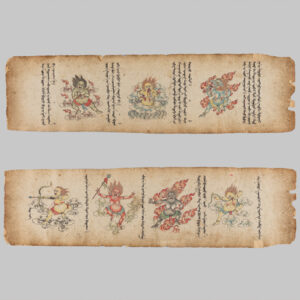
Read the transcript of this episode.
Everyone has spent time wondering about it, but no one can say for sure: What happens after we die? In the last episode of the season, all of the guests in the series consider this question and consider how believing or not believing in the afterlife impacts how they live. If death is simply a transition from one state to the next, then how do we imagine life after?
AWAKEN Season 3 is hosted by singer and songwriter Falu. Guests featured in this episode include Visionary artists and founders of the Chapel of Sacred Mirrors Alex and Allyson Grey, poet Marie Howe, writer and professor Kiese Laymon, artist, director, and author Chella Man, professor, clinical psychologist, and scientist Dr. Lisa Miller, writer and editor Haley Nahman, artist and podcaster Nigel Poor, Tibetan Buddhist meditation teacher and author Yongey Mingyur Rinpoche, meditation teacher and writer Sebene Selassie, neuroscientist and author Dr. Jill Bolte Taylor, author and poet Michelle Tea, neuroscientist Dr. Kay Tye, and meditation teacher and author Spring Washam. Learn more about our guests.
ABOUT THE ARTWORK FROM THIS EPISODE

Illuminated books became very popular in nineteenth-century Mongolia, and unlike many Buddhist texts that were reproduced using block prints, most of these books were hand written as is true of this text. This manuscript of the Tibetan Book of the Dead, a guide to navigating the intermediate state of consciousness between death and rebirth, or the bardo, features a vertical Uyghur-based Mongolian script that was instituted by order of Chinggis (Genghis) Khan (reigned 1206–1227) in the early thirteenth century.
These vividly painted illustrations are meant to prepare practitioners for the series of visions that are said to occur at death, which take the form of a series of peaceful and wrathful deities. Painted illustrations translate the written word into easily recognized and memorable forms and shapes, both peaceful and fearsome, that are meant to be visualized during the bardo practice in preparation for one’s own death or as part of the ritual at someone else’s death performed by a ritual specialist. In one folio, various female forms are depicted in active postures, each with a different animal head and body color. The colors relate to basic elements such as fire, air, and earth, and the animal heads are derived from Central Asian species of wild game along with some iconic Indian animals such as the elephant and boar.
PRODUCTION CREDITS
AWAKEN is produced by the Rubin Museum of Art with Jamie Lawyer, Sarah Zabrodski, Christina Watson, Gracie Marotta, and Tenzin Gelek in collaboration with SOUND MADE PUBLIC, including Tania Ketenjian, Sarah Conlisk, Philip Wood, Alessandro Santoro, and Jeremiah Moore.
Original music has been produced by Hannis Brown with additional music from Blue Dot Sessions.
OUR GENEROUS SUPPORTERS
AWAKEN Season 3 and Death Is Not the End are supported by the E. Rhodes and Leona B. Carpenter Foundation, Ellen Bayard Weedon Foundation, Robert Lehman Foundation, and The Prospect Hill Foundation.
The Rubin Museum’s programs are made possible by the New York State Council on the Arts with the support of the Office of Governor Kathy Hochul and the New York State Legislature.
Death Is Not the End is supported in part by the National Endowment for the Arts.

![]()

